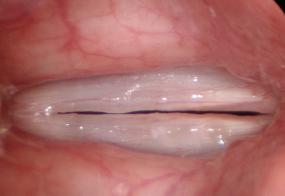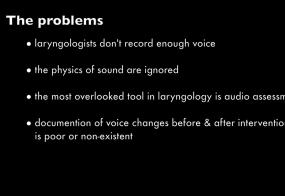Blog
Practice guideline articles seem like they should carry a lot of weight given the number of authors and their collective fame and recognition. Yet one of the pitfalls of writing by consensus is publishing something that is effectively the lowest common denominator. Since the article may be frequently quoted, let’s take a closer look at: Dhillon VK, Randolph GW, Stack BC Jr, et al. Immediate and partial neural dysfunction after thyroid and parathyroid surgery: Need for recognition, laryngeal exam, and early treatment. Head & Neck. 2020;1–16.
In lieu of travelling these next few months, I have placed online one of my favorite lectures about identifying a voice disorder by sound - Phonogram. You could reasonably ask, Why should the examiner listen to the voice? Seeing sound. I am a visual person you say. I went into a surgical speciality for my talent to see something and remove it, yet, my ear isn’t well trained. I can’t carry a tune, but I specialize in laryngology and my patient is hoarse, a complaint about sound. Sound is created by the movement of air and I can’t see air, how do I visualize sound?
Vocal capabilities pattern matching Reviewing the four Vocal Capabilities Pattern examples, we can begin to visually see that combining loudness and pitch reveal patterns. Clear sound is coded in green. Roughness is encoded Red and Breathiness is encoded in Blue. Vocal cord margin swellings With impairments at low volume and high pitch we see a graph with audible pathology on the lower right side and that points toward vocal swellings.
Abstract A voice laboratory is an expensive proposition when the most current equipment options are purchased; consequently, a voice examination can be an expensive proposition as well. An examiner having the latest equipment and high definition technology offers the ability to see larynx anatomy and function in finer detail than in the past.
Specifying pitch and volume when looking at vocal cords is essential. If we take the example of vocal swellings, voice may be clear at some pitch and volume combinations. Yet with the same pathology at other pitch/volume combinations, vocal swellings often have combined sonic elements of air leak and polyphonia.
Case study History Gabriella is a performer with nightly shows for another 4 weeks. She is having difficulty with her voice giving out by the end of each performance. Even while I listen to her tell me her history, I can hear a husky quality to her voice. Vocal Capabilities
Thieme published a chapter on Voice modification in "Gender Affirmation Medical and Surgical Perspectives", edited by Christopher Salgado, Stan Monstrey and Miroslav Djordjevic. This chapter, from pages 31-50, covers several different approaches to modifying the male to female voice surgically. It has a complete set of photographs of Feminization Larynoplasty along with details about the surgical technique. The textbook is available from the publisher and on Amazon.com.
I presented a short description of some of the work I am doing to modify the comfortable speaking pitch and pitch range of transgender individuals wishing to sound more feminine at the 23rd WPATH Symposium in Amsterdam, The Netherlands on July 20, 2016. It included thoughts on the five procedures currently utilized to alter pitch: Cricothyroid approximation (aka Thyroplasty Type I) Vocal cord webbing (aka " Vocal Fold Shortening with Anterior Commissure Advancement" or VFSAAC, Wendler Glottoplasty)
An outstanding meeting just finished in Genoa, Italy for the 11th European Laryngological Society meeting hosted by president Giorgio Peretti on June 8-11. I found a bit of time to recap the meeting in photos. with the full set available for download on Flickr. There were many great presentations. It was extremely educational, particularly the discussions between and after the meetings. Some members found time for recreation in the form of eating, swimming, singing and dancing. In particular, the evening spent up on the hill at the Villa Lo Zerbino was spectacular. See you in 2018.
This short video was produced for the European Laryngology Society's meeting in Genoa, Italy. It was limited to 10 minutes and briefly covers the rationale behind listening to the voice in order to make a diagnosis.The premise is that it is necessary to alter pitch and volume while listening to the voice in order to establish the pattern which is characteristic and different for each type of voice disorder.








